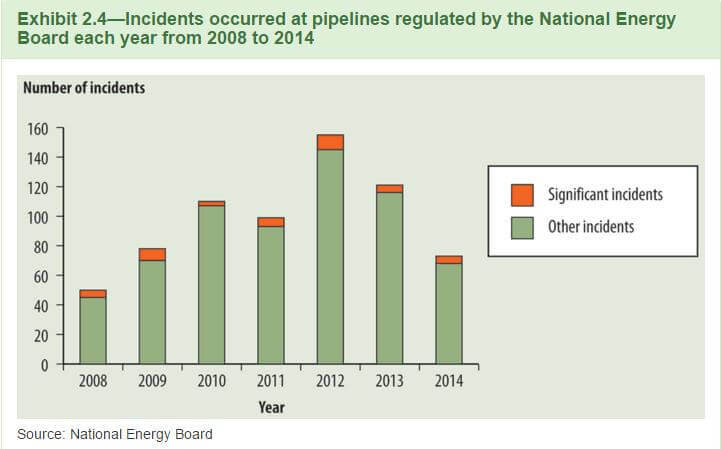
In her 2015 Fall Reports presented to Parliament today, the federal Commissioner of the Environment and Sustainable Development says that half the pipeline projects her office examined hadn’t met the conditions placed on their approval.
It was just one of the gaps commissioner Julie Gelfand found while looking at the National Energy Board’s oversight of federally-regulated pipelines.
“Our audit concluded that the National Energy Board did not adequately track companies’ implementation of pipeline approval conditions, and that it was not consistently following up on company deficiencies,” Gelfand says in a video about the audit. “We found that the Board’s tracking systems were outdated and inefficient. We also concluded that the National Energy Board is facing on-going challenges to recruit and retain specialists in pipeline integrity and regulatory compliance.”
THE RESULTS
Gelfand’s office — a part of the Office of the Auditor General of Canada — found that the NEB has inadequately tracked whether companies are complying with pipeline approval conditions. It determined that in nearly half of the cases examined (24 out of 49), the board’s tracking was inaccurate or out of date, key documentation was missing, or files lacked a final analysis as to whether the company had satisfied its approval conditions.
In the 24 cases where conditions had not been properly tracked, the type of inadequacies uncovered by the audit include:
- the Environment and Safety Information Management System, which is the core information system that the NEB used to track compliance, was out of date or inaccurate;
- NEB analysis or conclusion on company compliance was missing; or
- the desired end result of a condition had not been achieved or properly documented.
Gelfand noted that pipeline approval conditions are put in place so pipelines are built and operated safely in Canada. Conditions are project-specific and can cover a range of topics, such as protection of critical habitat or safety and engineering issues.
The audit determined the information management systems the board uses to track company compliance are outdated, inefficient and not integrated with each other.
Gelfand recommended that the NEB should systematically track compliance with pipeline approval conditions and adequately document this oversight work.

Auditors also looked at how well the NEB did on following-up with companies who are non-compliant with regulatory requirements. It found that in more than half of the cases examined (22 of 42), the board follow-up was either inconsistent or improperly documented. For example, auditors said compliance tracking information was out of date or inaccurate, the timeliness of the board’s follow-up varied, or the board’s analysis or conclusion on company compliance was missing.
In its recommendation, Gelfand’s office said the NEB should systematically verify that companies put in place corrective actions to non-compliance situations within the required timeline, which includes notifying companies when the corrective action is satisfactory.
Other findings from the audit include:
- The NEB has faced ongoing challenges to recruit and retain skilled and experienced staff
- The NEB has improved public access to information on companies’ compliance with regulatory requirements but not with pipeline approval conditions;
- The NEB has improved its review of company emergency procedures manuals, but a third of the manuals need to be updated;
- The NEB could consolidate its risk assessments into its emergency management plan to better inform the plan.
THE CONCLUSION
The audit of NEB oversight examined whether the board:
- was verifying that companies were complying with pipeline project approval conditions and regulations;
- was prepared to meet its role in pipeline emergency response and verified that companies’ emergency manuals were complete and up to date; and
- had assessed its capacity to deliver on its responsibilities.
Overall, Gelfand’s office determined that the NEB needs to do more to effectively adapt and evolve to keep pace with pipeline project proposals, the public’s interest and expectations, and recent regulatory changes.
The other two audits included in the Fall 2015 Reports looked at pesticide safety and the progress made on sustainable development strategies across federal departments. More on these to come.

